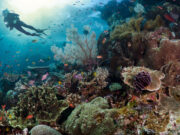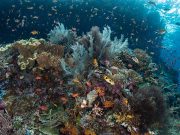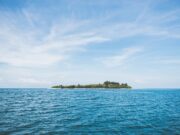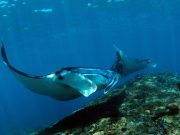From the cool Atlantic waters in the north to the warmer Mediterranean Sea in the south, Spain has a fascinating array of dive destinations and over 480 dive sites. New divers will appreciate the easy shore dives and colourful reefs, whilst experienced divers explore the many marine reserves and wrecks just offshore. Hosting the picture-perfect Canary and Balearic Islands as well, Spain’s rich waters are visited by whales, dolphins, sea turtles and countless fish. All of which means Spain offers some of the best diving in Europe. Are you looking for a summer vacation with a difference? Let’s explore where to go diving in Spain.
6 great places to go diving in Spain
1. The Balearic Islands
Sitting off eastern Spain, the Balearic Islands have outstanding diving in calm, crystal-clear waters. Made up of five islands and containing seven marine reserves teeming with life, these islands are a jewel in the crown of Mediterranean diving.
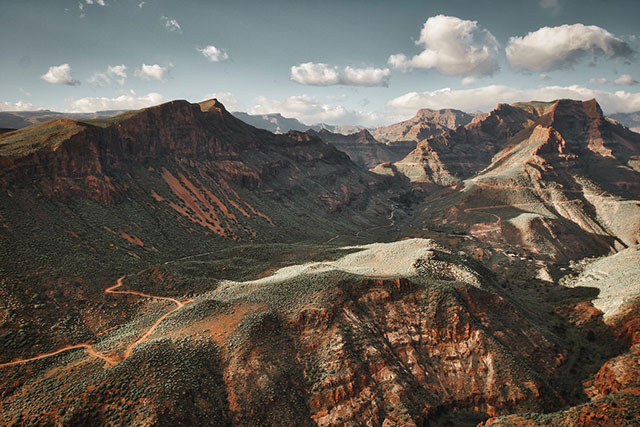
There are plenty of shore dives and dramatic underwater landscapes to explore, such as sheer walls and caves. As well as hosting large pelagic fish, the Balearics have plenty of macro life, including vibrant nudibranchs and seahorses.
Mallorca is known for its rich marine life and Sa Gleda Cave. This huge cave is the longest underwater cave in Europe and is perfect for technical divers. Nearby Ibiza is famous for being a party island, but it also hosts unspoilt dive sites along stretches of its peaceful coastline.
Menorca might be less well known than its neighbours, but it has beautiful rocky bays and some of the best diving in the area, which few people are aware of. Meanwhile, Formentera has lush seagrass beds and unusually calm waters that make it a perfect spot for underwater photography.
That said, if you only go diving in one place in the Balearics, make it the Cabrera National Park. This uninhabited archipelago of 19 islands is Spain’s largest national park and has some of the best-preserved seafloor landscapes in the entire Mediterranean.
Where to go diving:
- Majorca
- Menorca
- Ibiza
- Formentera
- Cabrera National Park
2. Basque Country
Basque country in northern Spain sites on the northern Atlantic coast and is quite unlike any other area of Spain. Famous for its beaches, striking modern architecture and mouthwatering cuisine, it is a feast for the senses.
The rugged Basque coast is dotted with high cliffs and small inlets, plus numerous rocky dive sites. Most notably, it is home to the Bay of Biscay. Hit by some of the Atlantic’s most ferocious weather, especially during winter, the Bay of Biscay can be challenging to dive but don’t let that put you off.
There are plenty of sheltered, shallow dive sites among the inlets and coves, and if you like the thrill of challenging cold-water dives, this is a great place for you. You’ll be rewarded with dive sites mostly to yourself and the opportunity to dive an underwater winery at Plentzia Bay.
Where to go diving:
- Bay of Biscay
- Plentzia Bay
3. Andalucía
The rolling hills, sparkling rivers, and farmlands of Andalucía shelter some of Spain’s most striking landmarks, including the famous Alhambra Palace and the Mosque-Cathedral of Córdoba.
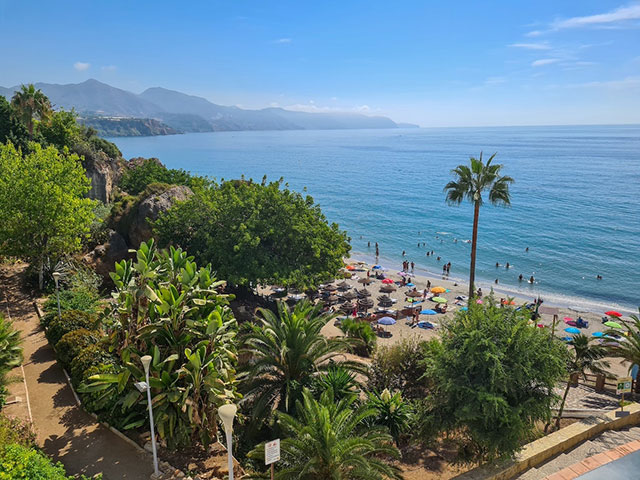
Below the water is equally as eye-catching, with extensive seagrass meadows, rocky walls, pinnacles and dramatic swim-throughs. Andalucía’s year-round clear, warm waters and mixture of rugged coast and gently-sloping sands make it a great destination for every diver.
There are numerous colorful reef and wreck dives, plus deep dive sites busy with fish and swathed in soft corals. Wherever you dive at this beautiful destination, make sure you include a trip to Cabo de Gata whilst you are there. This marine reserve is one of the most untouched areas of the Mediterranean Sea.
Where to go diving:
- Costa del Sol: Estepona, Nerja
- Cabo de Gata
- Tarifa
- Almuñécar
4. Murcia
Tucked between Andalucía and Valencia, the province of Murcia is dotted with dozens of dive spots and hosts abundant marine life. There are coral-encrusted wrecks at Cabo de Palos (Cape Palos), caves and crevices with red and black gorgonians, and delightful shallow seagrass beds.
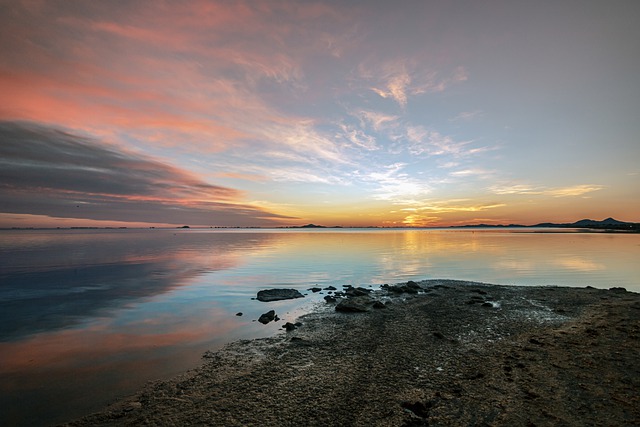
Diving at Mar Menor (Small Sea), the largest natural lake in Spain and the largest salty lagoon in Europe, is a must and the thriving Islas Hormigas Marine Park is equally as unmissable. If you head north into Valencia, you can also dive at the far-flung Columbretes Islands, a volcanic archipelago that hosts huge schools of fish.
If that all sounds like too much effort, you can simply explore Murcia’s miles of calm waters and sandy shores all day long. With so much on offer, this area is surely one of Spain’s best-kept secrets when it comes to excellent Mediterranean diving.
Where to go diving:
- Islas Hormigas Marine Park
- San Pedro del Pinatar
- Mar Menor
- Águilas
- Columbretes Islands (Valencia)
5. The Canary Islands
The rugged volcanic landscapes of the Canary Islands are a photographer’s dream with their azure waters, bougainvillea-lined streets, and golden sands. They are one of the most popular destinations in Spain and offer some of the best Atlantic Ocean diving.
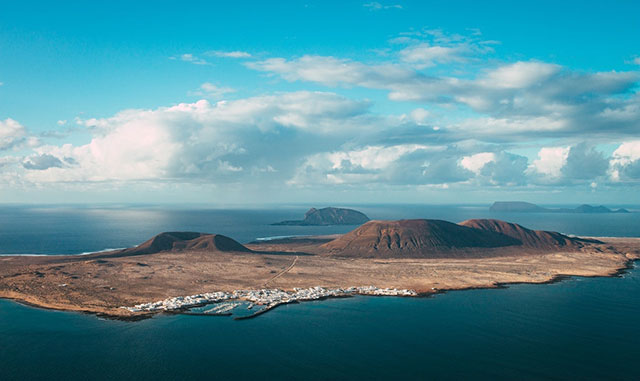
Whether you are a new diver or advanced, the Canary Islands have plenty to enjoy. Each island has its unique charm and the surrounding underwater landscape plunges to 1000 meters – hosting black lava structures, caves, reefs and wrecks along the way.
The waters are warm almost all year and the visibility reaches up to 30 meters, making the Canary Islands a perfect place to get your diver license. Added to that, these special islands host everything from dolphins, whales, and numerous sea turtles to tiny seahorses.
If you love rays, go diving in Tenerife. There you can find stingrays, bull rays, butterfly rays, plus occasional visits by torpedo and mobula rays.
Where to go diving:
- Lanzarote
- Fuerteventura
- Gran Canaria
- Tenerife
- La Gomera
- La Palma
- El Hierro
6. Catalonia
Stretching along the northeastern coast of Spain and close to Barcelona, the Costa Brava is a popular tourist destination with outstanding diving. It is one of the easiest places to go scuba diving in Spain, with numerous shore dives and accessible boat dives.
The Medes Islands, sitting in the heart of the Costa Brava, are a rich marine reserve with caves and tunnels full of life – including gorgonian corals and 30-kilogram groupers. Sunfish have also been spotted there.
There is a host of interesting dive sites on the doorstep of Barcelona and around nearby Tarragona, including the wreck of a World War II bomber plane, the Heinkel. This wreck is one of the few remaining examples of Heinkels in the world and has become a thriving artificial reef.
Further north, lie the dramatic Catalan Pyrenees. This adventure playground isn’t just for mountaineers. There are numerous lakes in the area which offer ice diving during winter.
Where to go diving:
- Costa Brava
- Medes and Formigues Islands
- Barcelona area
- Tarragona
- Catalan Pyrenees
What marine life can you see when diving in Spain?
With coastlines along the Mediterranean Sea and the Atlantic Ocean, plus islands in the Balearic Sea, Spain has a unique mixture of marine life large and small.
There is a multitude of reef and pelagic fish, colorful soft corals, moray eels, octopi and macro life at Spain’s Mediterranean dive destinations. In contrast, the cooler Atlantic waters are visited by schools of sardines, anchovies and mackerel.

Sunfish are known to visit Andalucía and Catalonia, whilst Spain’s islands host dolphins, rays, whales and numerous sea turtles. If you’re lucky, you might even spot blue sharks in the Balearic Islands.
What experience do you need to go diving in Spain?
One of the best things about diving in Spain is that it is suitable for all experience levels.
Whether you want to try scuba diving for the first time or tackle exciting advanced dives, Spain has numerous dive spots to choose from.
When is the best time to go diving in Spain?
You can dive all year in Spain, though the best time to visit depends on where you go:
- The Balearic Islands: All year.
- Basque Country: July and August.
- Andalucía: April to October.
- Murcia: July to September.
- The Canary Islands: All year.
- Catalonia: May to September (or winter for ice diving).
Kathryn Curzon, a shark conservationist and dive travel writer for SSI (Scuba Schools International), wrote this article.
Main photo credit: Michael Tomlinson/Unsplash






